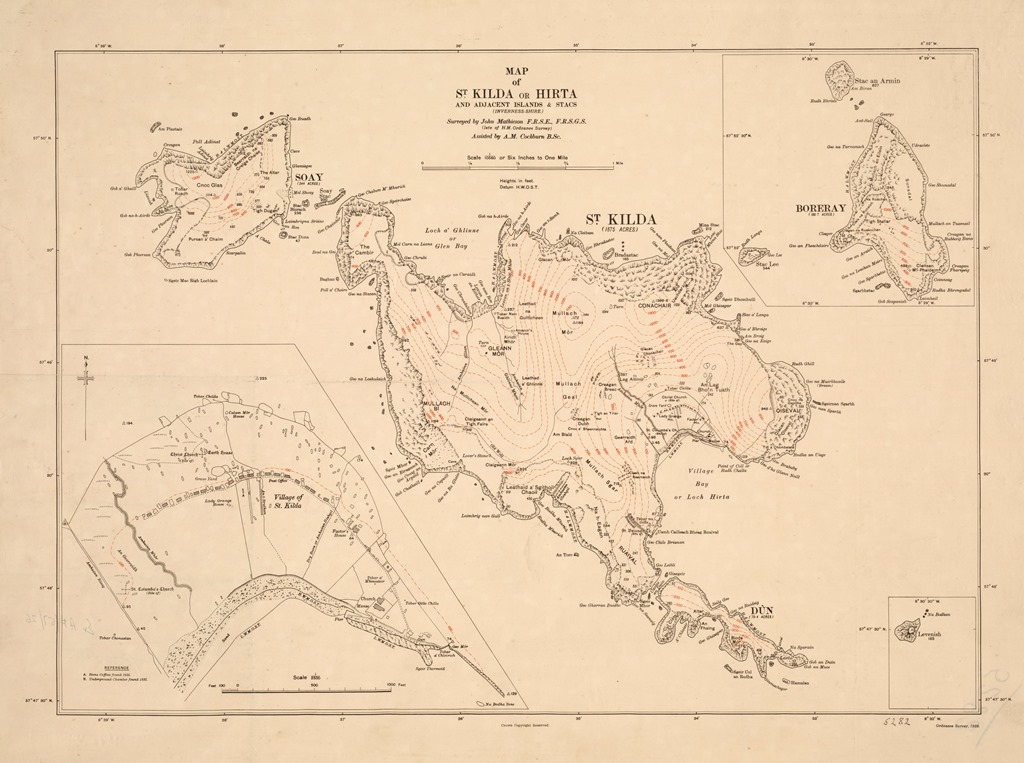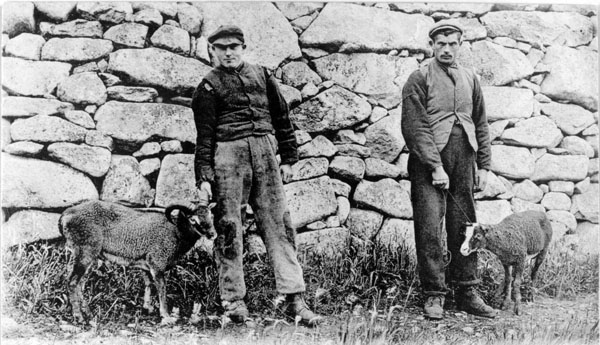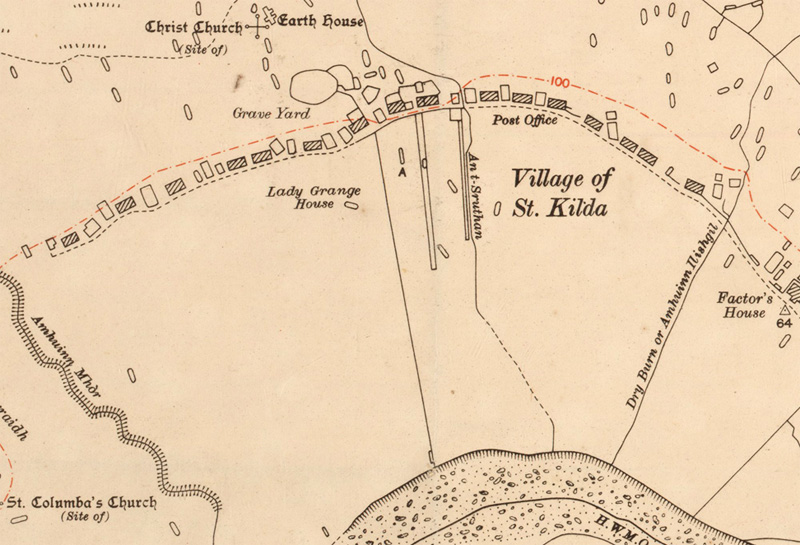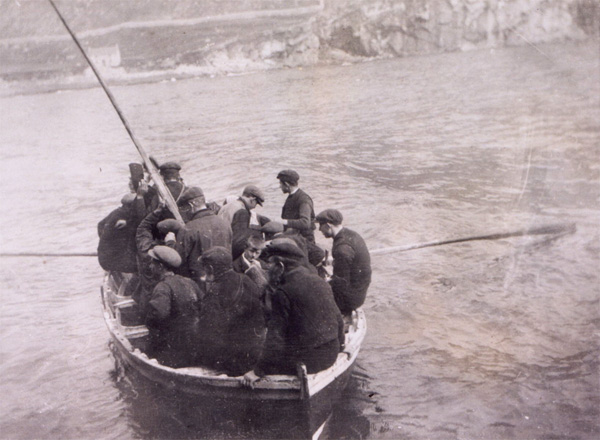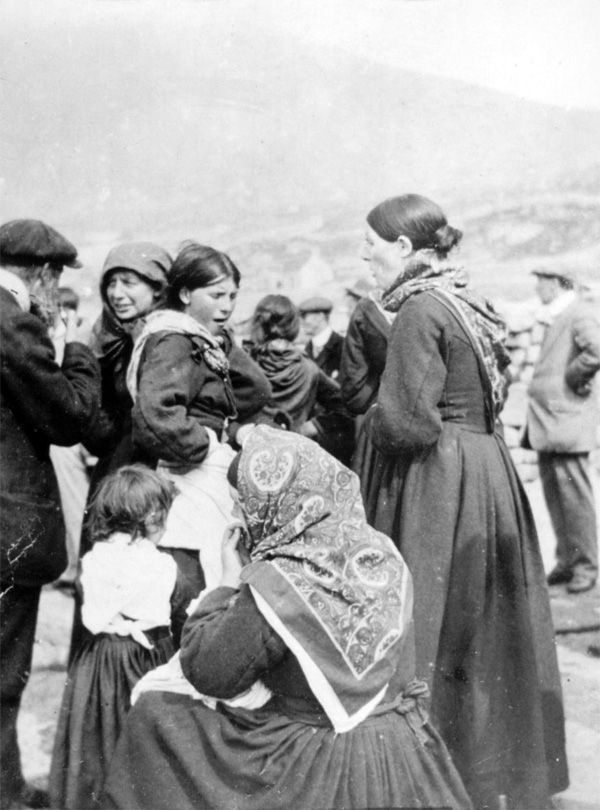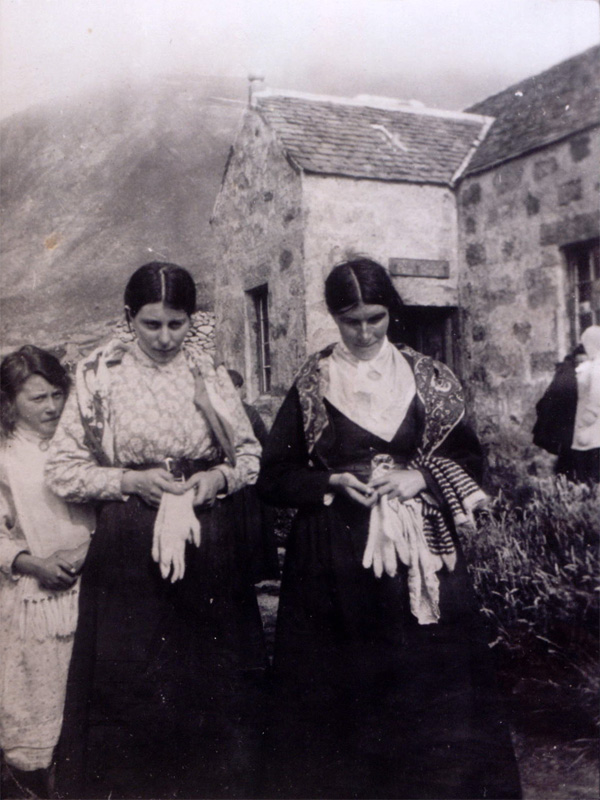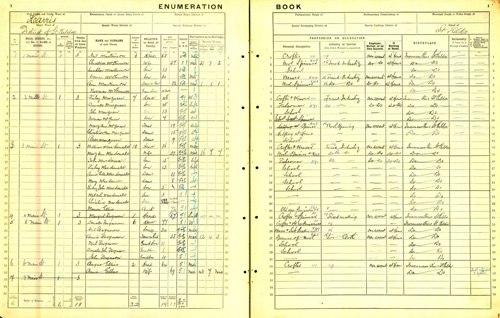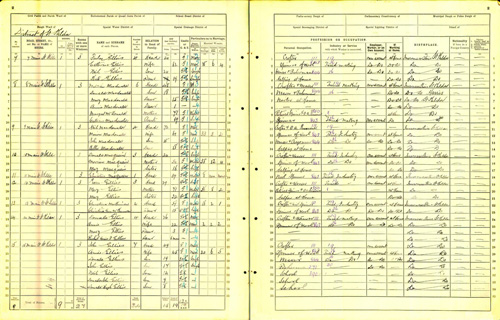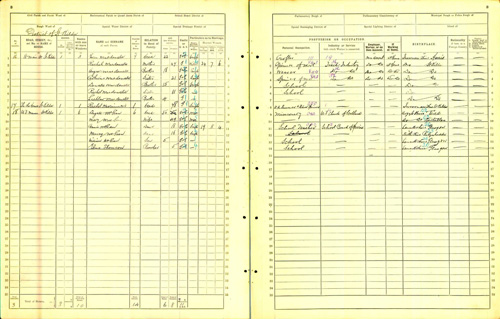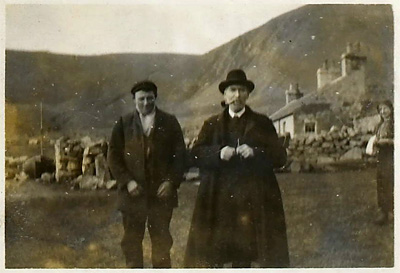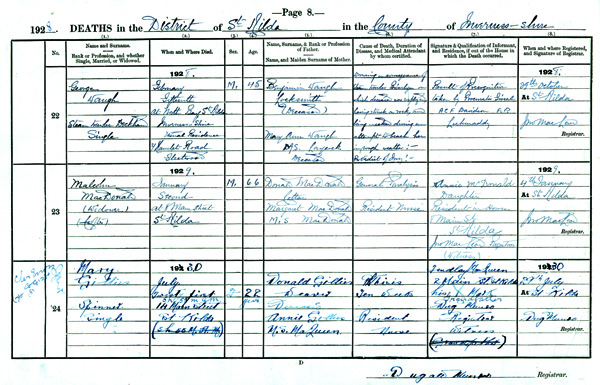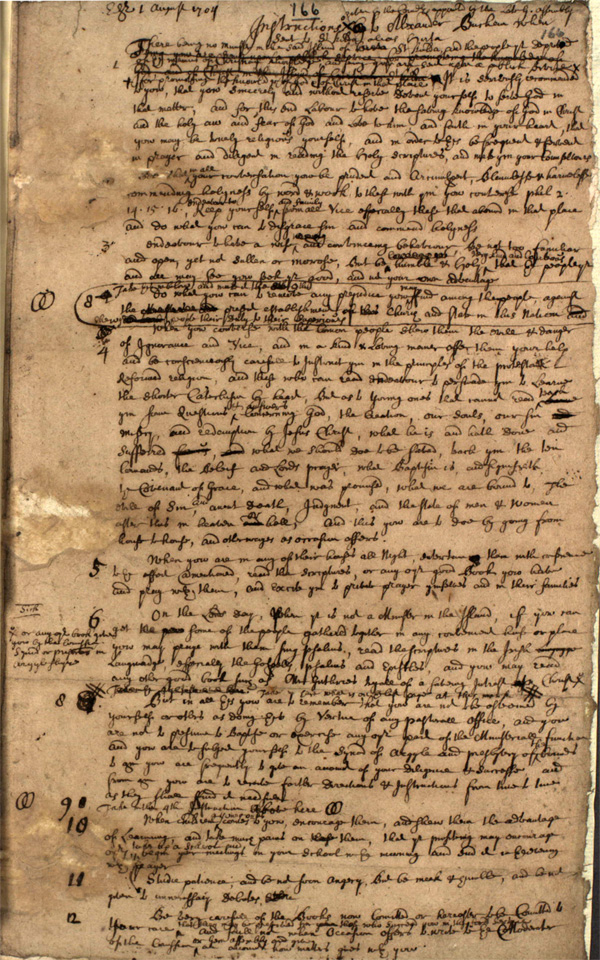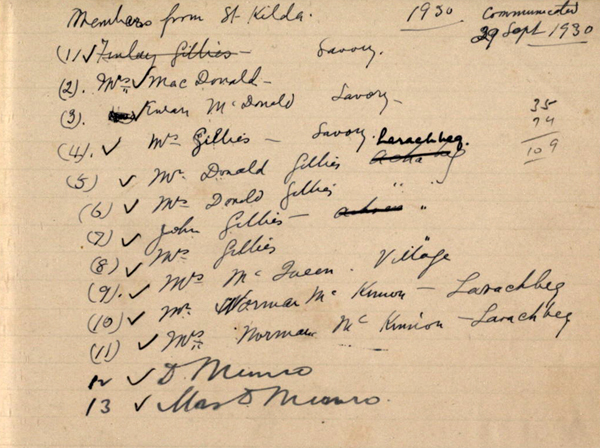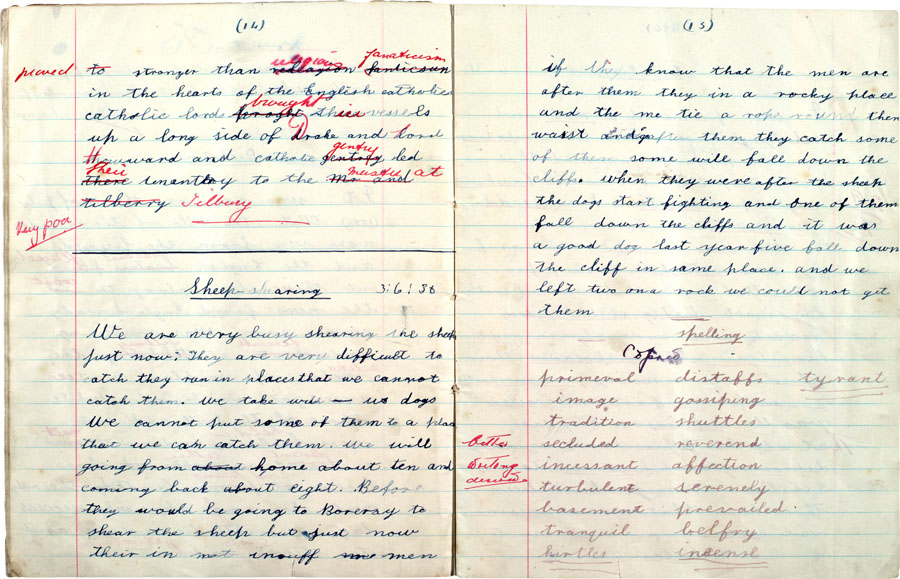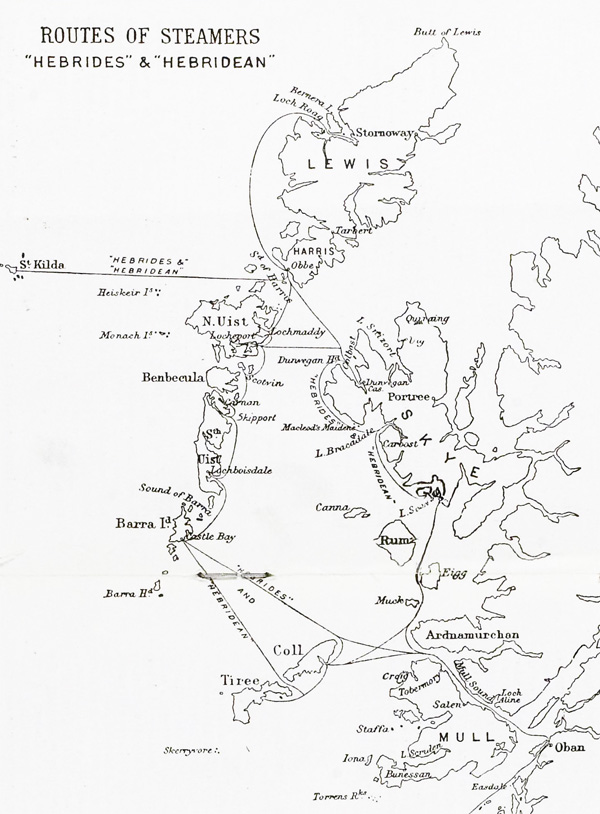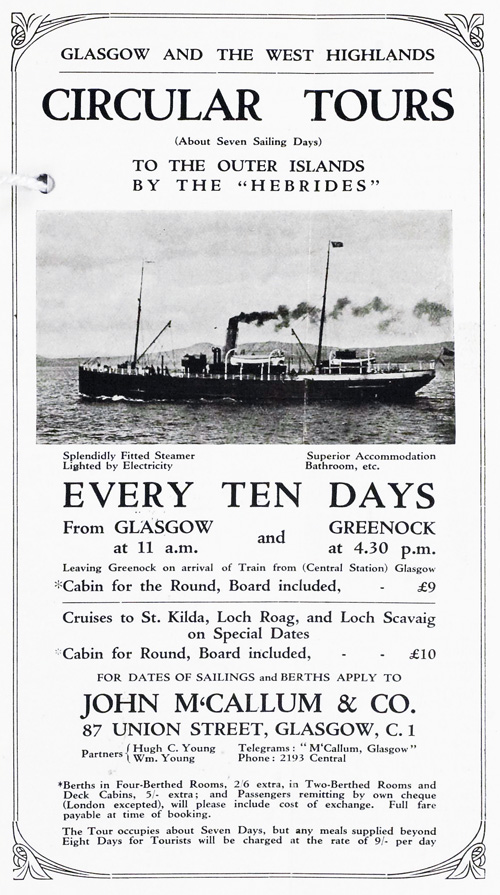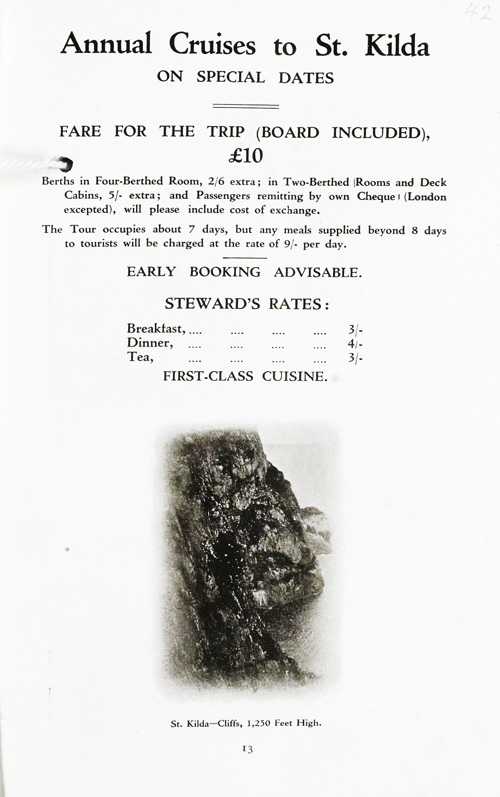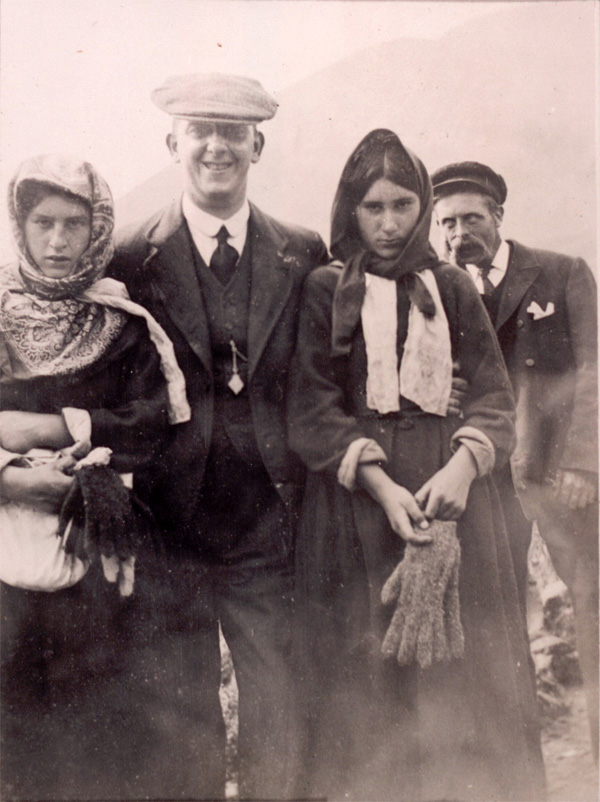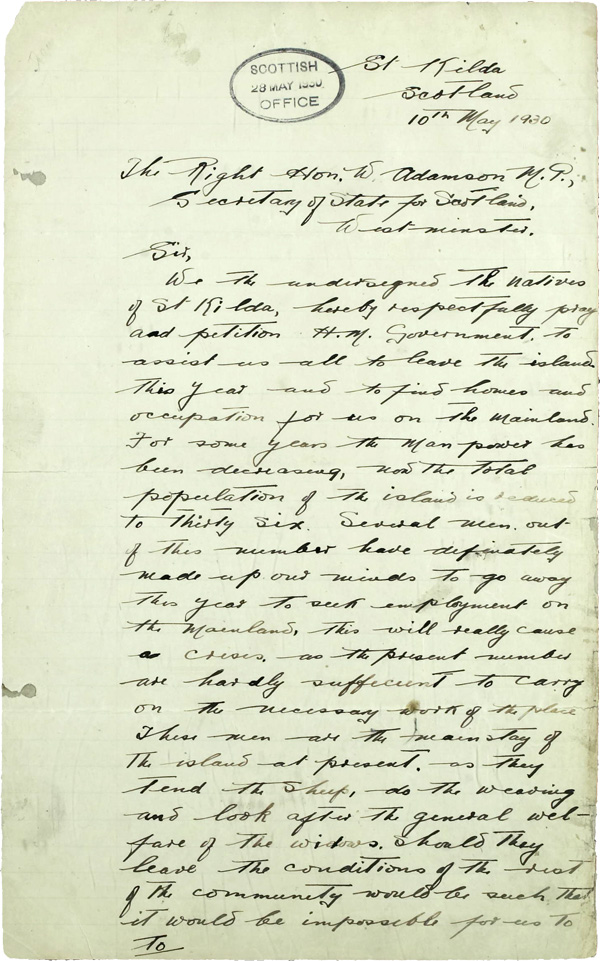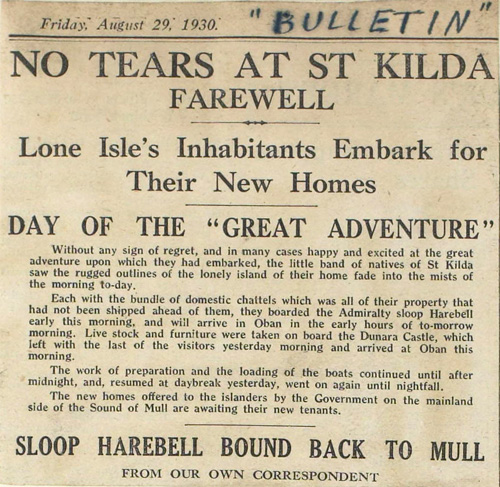Stories from St Kilda
Stories from St Kilda

The remarkable history of the island archipelago of St Kilda and its hardy inhabitants is extensively documented in archives held by National Records of Scotland. The unique documentary sources range from evidence of the Church of Scotland’s missionary activity on St Kilda in the early eighteenth century, to Scottish Office files containing an extraordinarily detailed picture of the government’s efforts over many decades to help the islanders, and ultimately to evacuate the remaining inhabitants in 1930. The ‘after-life’ of the island is also documented in official records which bring the story nearer the present day. Underpinning all these important records are the parochial records, statutory registers and censuses, which provide vital evidence of individuals and families from 1830 onwards, and can be searched on ScotlandsPeople.
A remote island community
St Kilda lies more than 40 miles west of the Outer Hebrides off Scotland’s north-west coast. Hirta is the largest island and the site of the only settlement, while the smaller islands of Soay, Boreray and Dun offered additional pasture. All of them are dominated by cliffs and crags which are home to seabirds. The islands and their inhabitants have been the object of a unique and enduring fascination for the rest of Scotland and the wider world. Other abandoned Scottish islands have interesting histories, but none has appealed to the outside world as much, or inspired so much attention. Some of the huge historical literature about St Kilda has drawn upon archives held in National Records of Scotland. Some interesting examples of the original historical documents are presented here.
Map of St Kilda or Hirta and adjacent islands and stacs,
by John Mathieson and A M Cockburn. 6 inches = 1 mile,
published by Ordnance Survey, 1928.
National Records of Scotland, RHP5282
Way of life
Life on Hirta was made possible by freshwater springs, and for centuries the islanders survived by eating the meat and eggs of seabirds, fish caught near the islands, and such barley, oats and potatoes as they could grow and store to last the winter. Oil from fulmars and other birds provided them with fuel for lamps.
The islanders kept sheep on Hirta and the smaller islands of Soay and Borerary. The distinctive Soay sheep was well suited to the harsh and precipitous island conditions, and produced a distinctive soft wool. The St Kildans also kept a few cattle. A schoolboy’s vivid description of the difficulties of sheep-shearing on Boreray in 1930 can be read below.
Islanders and Soay sheep, c1913
National Records of Scotland, GD1/713/1
In 1885 J Acheson, a surgeon, reported that food was abundant on St Kilda but lacked variety. There were no fruit or vegetables, apart from a few poor quality potatoes. The islanders ate oatmeal, salted fowl, and seabird eggs during summer and salted mutton in winter. They obtained tea, sugar, flour and tobacco from tourists and from the owner's factor (Agriculture and Fisheries Department file, AF57/5).
The islanders lived in houses strung along a 'main street', with plots of land and common ground on either side. In 1861 the landlord replaced the traditional thatched 'blackhouses' with sixteen single storey cottages with chimneys and slate roofs.
Map of St Kilda or Hirta and adjacent islands and stacs (detail),
by John Matheson and A M Cockburn. 6 inches = 1 mile,
published by Ordnance Survey, 1928.
National Records of Scotland, RHP5282
The islanders were vulnerable when weather prevented them from gathering food, or even destroyed their stores, as happened in the late summer of 1885, when the islanders’ corn, barley and potatoes were ruined in a bad storm. With the people facing starvation, on 16 September the minister sent a desperate plea for help. The message was placed sealed in a bottle on one of the miniature boats used for messages, and it was duly received on Harris.
A St Kildan ferry boat, c1913
National Records of Scotland, GD1/713/1
St Kildan women, dressed in their best clothes for the
benefit of visitors off the SS ‘Hebrides’, c1913
National Records of Scotland, GD1/713/1
Population
Visitors to the island often recorded the number of inhabitants, but not their names. In the late seventeenth century St Kilda supported 180 inhabitants. During the eighteenth and nineteenth centuries the population fluctuated but decreased overall, mainly as a result of disease and migration. An outbreak of smallpox in 1727 reduced the population dramatically to 42 people, and it was reported in 1758 that there were 88 islanders.
A previously unknown census, discovered in 2015 in a private collection, reveals the names of the islanders in 1764, almost six decades before a list compiled in 1822, hitherto believed to be the earliest known complete census. The 1764 document records 90 islanders, 38 males and 52 females, and is organised by household, giving a total of 19 families and 9 individuals (widows, widowers or unmarried). Many of those recorded in the 1764 census were the families of new settlers from Skye and Harris: Gillies, MacQueen and McCrimmon replacing the old St Kilda names of MacDonald, Morrison and Campbell.
The dietary needs of the islanders in 1764 are also recorded. It was said that each of them ate 36 eggs and 18 fouls daily, making a staggering total of 3,240 eggs and 1,620 birds.
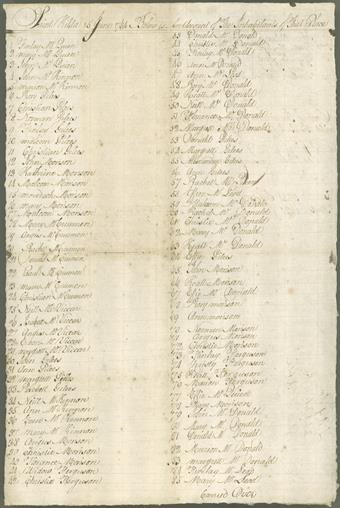
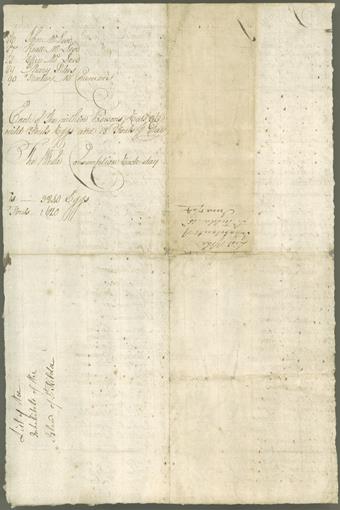
List of inhabitants of St Kilda, 1764 (42 and 35 KB jpegs)
NRAS Survey 4360/7/2, courtesy of the Lachlan Trust
It may be possible to suggest family connections between individuals in 1764 and later records, such as the 1822 census which lists the ages of the family members. The earliest islander whose likeness we have is Effie (Euphemia) McCrimon or McCrimmon, who lived to be photographed in 1860, nine years before her death at the age of 88 years. She was born around 1781, the daughter of Donald McCrimon and Kate McKinnon. Was he the ‘Donald McCrumen’, number 21 on the 1764 list?
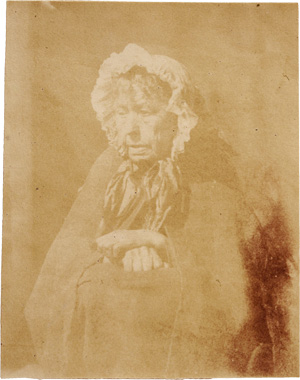
Effie McCrimon, ‘a reverend St Kildean spinster of 80’, photographed
by Captain F W L Thomas RN in 1860 (55 KB jpeg)
Courtesy of the Society of Writers to Her Majesty’s Signet, NRS, GD492/12/6
In 1841 the private census taken by a visitor counted 105 people. The departure of 36 islanders for Australia in 1852 caused a sudden drop in the population, which had stood at 112 in 1851. The 1861 census counted 71 islanders, and 50 years later in 1911 the islanders only numbered 74, and ten years later stood at 71. In the 1920s deaths and migrations saw a dramatic drop to only 43 islanders in 1927. This was a critical level that raised the old doubts about how the island community could survive.
Christina Ann McQueen (centre), daughter of Finlay McQueen,
outside the factor’s house, St Kilda, c1913
National Records of Scotland, GD1/713/1
The most recent census of St Kilda that is available to study was taken in 1911. The crowded households indicate how unhealthy and inadequate the islanders’ houses were. Most adults pursued their traditional livelihoods, working their crofts, gathering and spinning wool, weaving tweed and fishing. Some of the inhabitants listed here, for example three of the younger Mackinnons at no. 1 Main Street and Finlay MacQueen at no. 2, were among the islanders who stayed to the end in 1930.
The Census recorded a total population of 74 islanders, all natives, except two born in Harris. In addition there were six in the manse.
St Kilda Census 1911, National Records of Scotland, 1911 Census, 111/04 001/00 002
Taking the census in spring 1911 was a challenge because the irregular calls at St Kilda by fishing boats were unreliable. That year's summer visits by passenger ships had not yet started, and anyhow would have been too brief for the enumerator to record all the inhabitants' details. As with previous censuses, the Admiralty helped the Registrar General for Scotland. On 19 April HMS ‘Pathfinder’ landed the enumerator on St Kilda and delivered the first mail the island had received since late January. The census enumeration thus took place almost three weeks later than in the rest of Scotland.
Rev Dugald Maclean and a St Kildan youth, 18-20 April 1911
National Records of Scotland, GRO5/324/80E
St Kilda was a registration district in its own right, and the minister or the school teacher acted as local registrar, recording births, deaths and marriages. The longest served was the Rev John McKay, from 1865 until 1889. The standard of entries in the registers often fell short of the consistency and accuracy found in districts where the registrars’ work could be regularly inspected. In 1911 Dugald Maclean (1858-1924) from Tiree was in post, but was gone by 1912. He was the United Free Church’s missionary in several places in the Outer Hebrides before and after his time on St Kilda. His wife Mary kept house in the manse while Annie, aged 18, the eldest of their three children living with them, was the island’s teacher. The last registrar, Rev Dugald Munro, was appointed in 1929. Next year he accompanied some of the islanders to their new home in Morvern.
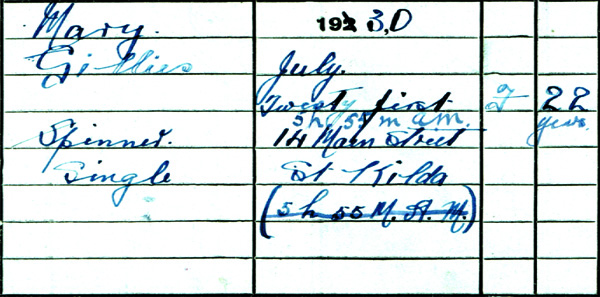
Register of Deaths, St Kilda, 1921-30
Crown copyright, National Records of Scotland, 111/4/22-24
Recorded here are the last islander to die on St Kilda, Mary Gillies on 21 July 1930, Malcolm MacDonald, after whose death in 1929 his daughter left the island, and one of the eight trawler crew drowned in a wreck on St Kilda in 1928.
Health care
One challenge for any remote community is adequate health care. On St Kilda nurses had been provided by the landowner but by 1890 Miss MacLeod had "given up hope of satisfying the islanders due to their peculiar customs and prejudices" (Agriculture and Fisheries Department file, AF57/1).
Health in rural communities was a growing concern more generally. In sparsely populated areas, with difficult terrain and poor transport, many people were miles from a doctor and often too poor to pay medical fees. Many deaths also went uncertified because there was no medical attendance.
Following the 1904 Report of the Medical Relief Committee and the 1912 Dewar Report into healthcare provision, the government created and funded the Highlands and Islands Medical Service to improve health care for many Scotland's crofting communities. The service was not free but fees were minimal, doctors received financial support for travel and grants could be made available - such as that for keeping the hospital at Fort William open.
In February 1914 MacLeod of MacLeod expressed support for a fully qualified state sponsored nurse for the islanders and offered the ground floor of a factor's cottage for her accommodation (Agriculture and Fisheries Department file, AF57/16). A salaried nurse was duly provided for St Kilda in the form of Nurse McLennan, who reported an outbreak of influenza in May 1914:
"I had not nearly enough of internal medicine to cope with this epidemic but did the best with what I had, also some I had of my own. So will you please get the doctor to send some various medicines, - cough mixture, - also some tabloids: he will know; Epsom salts, mustard, and might there be something in the way of nourishment such as Bovril, Allenbury's diet, and barley, arrowroot. I have not yet opened the whisky or brandy. If I had given it to one and not the others at this time it would have caused discontent... This epidemic has paved the way for me to get their houses cleaned." (Letter to the Highlands and Islands (Medical Services) Board, 3 June 1914, AF57/17).
Her successor Nurse Aitchison wrote on 26 September 1914:
"I have started a weekly meeting in my own house for young women for first aid and home nursing and hygiene as it is almost impossible to teach them hygiene in their own homes... They are without exception the dirtiest people I ever nursed. I should like some printed forms for their houses such as Paisley Medical Officer of Health issues i.e. Please do not spit etc. They infect each other with colds spitting all over the place" (Medical Services Files (Highlands and Islands), HH65/12).
She also described what life was like for a St Kildan nurse:
"A winter here is quite long enough for any trained nurse. There is so much wet weather and no roads, that life here is imprisonment to any who has led an active life... I have only had fresh meat once this year. I have had no butter for weeks nor any fat of any kind. I had no potatoes and had to live on scones, now I cannot even have scones regularly, I have no milk" (Medical Services Files (Highlands and Islands), HH65/12).
A further eight nurses were stationed on the island between 1915 and 1930 when Nurse Williamina Barclay was evacuated along with the other St Kildans. On 21 July 1930 she wrote:
"Every day makes me more sure that it is a step in the right direction... One problem solved itself this morning, the girl whom you saw in no. 14 died. This is only another instance of the difficulties of St Kilda, her end was so distressing and I had to fight the battle single handed. I am looking forward to seeing the people happily settled on the mainland." (Agriculture and Fisheries Department file, AF57/27).
The Church
For most of its history, the St Kildans were without a resident minister. Baptisms and marriages were performed annually by the chaplain who would visit Hirta with the proprietor’s steward. Rents and teinds were collected at the same time. The first resident missionary was Alexander Buchan, appointed in 1705 to combat the surviving 'popish' practises and the general ignorance of the population.
Instructions for Alexander Buchan as minister and
school teacher, 1 August 1704, National Records of Scotland,
General Assembly of the Church of Scotland Papers,
CH1/2/4/2 f.166
Alexander Buchan was both missionary and teacher – a pattern that was to continue. He built the first manse on the island, taught the catechism to both adults and children and started a library, funded by charitable donations from the Society in Scotland for Propagating Christian Knowledge (SSPCK). His wife, who came to Hirta with him, is credited with having taught the St Kildans to knit.
Life as a missionary meant sharing the hardships of the islanders, and Alexander Buchan wrote frequent letters to the Presbytery of Edinburgh applying for money and detailing the difficulties of obtaining a livelihood on the island (CH1/2/31 ff.468-469 & 471-498). Life on St Kilda was about survival and Buchan discovered that the islanders did not value reading and writing – he had only four scholars in his school. The St Kildans embraced the reformed faith, however, which Buchan enforced with strict discipline. Buchan was plagued by ill-health throughout his time on St Kilda and eventually died of a fever in 1730. He left a population of St Kildans brought into the reformed religion.
During the next 75 years, a series of missionaries endured the living conditions and privations of life on St Kilda, establishing a schedule of regular church going and faith which was to dominate the lives of the islanders henceforth. Services were held in a barn until a proper church and manse were built in 1827-8 (replaced 1896).
Between 1830 and 1844, the missionary and teacher on St Kilda was Neil Mackenzie. Undr his care, the islanders became ardent church-goers, attending church daily (except for Monday and Saturday) and twice on Sunday. Attendance at every service was compulsory for everyone over the age of 2 years (unless sick). He also made strenuous efforts to help his people to improve their living conditions, introducing the idea of legs to raise tables from the floor and walls to keep livestock away from crops. The minister remained apart from the people and, as he was the only English speaker, they depended on him to enable them to communicate with the outside world.
List of former St Kildans receiving communion, 1930,
Deacon's court minute book of Morvern Free Church,
National Records of Scotland, CH3/726/1 f.117
In 1846, following two years without religious instruction and a visit to the island by a Free Church Deputy, all 103 inhabitants of St Kilda declared their adherence to the Free Church. Between 1865 and 1889, the minister John McKay saw to it that Sundays on St Kilda included three church services, no work and no conversation - only recitation from the bible was permitted. He also established church governance on the island, appointing two elders. His successor, Angus Fiddes, was the last ordained clergyman on St Kilda. He fulfilled the roles of both minister and teacher.
Education
As the State succeeded the Church as provider of education during the nineteenth century, an alternative to missionary schooling on St Kilda was established. Under the 1872 Education Act, education on St Kilda became the responsibility of the Harris Board. A school was finally built and opened in 1898. Attempts were made by the SSPCK in the late 19th century to appoint a female teacher but it was unable to find anyone willing to travel to such a remote destination. In 1919, Donald and Mary Cameron and their children arrived at the manse, and, as Mary was a qualified teacher, she shared the appointment with her husband.
These pages come from an exercise book that belonged to Donald Gillies, a 12 year old pupil at St Kilda primary school just before the evacuation of the island in 1930. Donald's book was found in the abandoned school in 1937 by visitors on a sailing holiday and donated to the archives forty years later by their daughters. Although the teacher marked Donald's dictation exercise 'very poor' and criticised his writing in the spelling practice, his essay on sheep shearing gives a vivid picture of the perils of life on the island.
Exercise book belonging to Donald Gillies, a pupil at St Kilda Primary School,
including essays on sheep rearing and visits to Boreray, 1930
National Records of Scotland, GD1/817/1
Transcription of passage about sheep shearing, National Records of Scotland, GD1/817/1
Tourism
Among the nineteenth century travellers to St Kilda were a number of tourists. The first steamship to anchor in Village Bay was the 'Glenalbyn' in 1834, causing 'excitement and astonishment' among the islanders (Gannon and Geddes, 'St Kilda, the Last and Outmost Isle', 2015, p.198). Few and far between to begin with, other early tourists included folklorist Alexander Carmichael (1832-1912), who sailed there on board a Royal Navy ship in 1865 to learn traditional songs. He also bought some cloth and fulmar oil, and "kissed a St Kilda lassie" (Edinburgh University Library, Carmichael Watson Collection, Coll-97 CW113/27). Another visitor was Henry John Elwes, a retired Scots Guards captain and ornithologist who arrived on the HMS. 'Harpy' in 1868 in search of the Great Auk. His trip included collecting fulmar eggs by descending the cliffs, local-style (Robson, 'St. Kilda, Church, Visitors and 'Natives', p.478).
Advertisement for trips to the Western Isles and St Kilda, c1929
National Records of Scotland, HH65/22
From the 1870’s onwards, cargo steamers with passenger cabins offered trips around the Hebrides and St Kilda began to feature in the itinerary. Vessels passing by were in the habit of whistle-blowing or canon-firing to startle the gannets and allow passengers to enjoy an ornithological show.
Chart showing routes of the steamships 'Hebrides' and 'Hebridean', c1929
National Records of Scotland, HH65/22
Private yachts also brought tourists to the remote isle from time to time, to meet the locals and see their way of life. In 1873 a Mr Young, the owner of the yacht 'Nyanza', expressed his surprise that the St Kildans seemed so happy and well off instead of miserable as he had supposed (R. Lawson, 'A Flight to St Kilda in July, 1902', 1902, p.16).
From 1877 the SS 'Dunara Castle' offered annual summer cruises to St Kilda bringing 40 day trippers per voyage to the island for a few hours’ exploration. The excursion included observing the cragsmen at work, purchasing eggs, cloth and stockings, meeting the inhabitants and ‘rambling through the hamlet’ (Robson, 'St. Kilda, Church, Visitors and 'Natives', p.478). The SS 'Hebrides' first voyaged to St Kilda in 1898 and continued to offer passenger cruises to the island as part of John McCallum & Co's West Coast itinerary.
John McCallum & Co Brochure advertising circular tours
to the outer islands and annual cruises to St Kilda, c1929
National Records of Scotland, HH65/22
The completion of a new pier in 1901 made it easier to land the visitors by rowing boat. Tourists continued to visit the archipelago up to evacuation and beyond.
A visitor from SS ‘Hebrides’ poses with two islanders, c1913
National Records of Scotland, GD1/713/1
Increasing contact with the outside world gave the islanders a broader view of the world and the possibilities of life elsewhere.
Evacuation
At the start of 1930 the St Kilda community was in a precarious state. Only 36 islanders remained: thirteen men, ten women, eight girls and five boys. Only two resident families included more than two children, and among the adults there were six widows and three or four widowers. They formed 10 households, leaving unoccupied 6 of the 16 cottages that they rented from the landowner. Learn more about the islanders and the 16 houses on St Kilda listed in the 1930 Valuation Roll on the ScotlandsPeople website.
The decision to evacuate the island archipelago was taken because life there was becoming untenable. So many islanders had left that the traditional livelihoods of raising sheep for wool, spinning and weaving tweed, fishing, and harvesting of seabird eggs and oil, was much harder to sustain. The islanders continued to suffer as weather conditions often prevented adequate food supplies, as well as mail, from being delivered between autumn and spring.
After the harsh winter of 1929-30 many of the islanders felt that they could not continue on St Kilda much longer. The authorities in Edinburgh as well as Williamina Barclay, the resident Queen’s Nurse, advised them of the benefits of leaving. Their health and well-being had long been a concern, and some recent illnesses and the tragic deaths of two young women in 1930 underlined the islanders’ remoteness from adequate medical facilities. On 26 May, Mary Gillies, of no. 10 Main Street, who had been rushed to hospital in Glasgow, died of complications after giving birth to her daughter Annie, who also died. She was 35 years old, married to John Gillies. On 21 July another Mary Gillies died at no. 14 Main Street of a form of tuberculosis, aged 22.
On the 10 May 1930, after many deliberations, twenty islanders petitioned the government for resettlement on the mainland. They stated that several men had decided to leave. Without them to tend the sheep, weave cloth and look after the widows, "it would be impossible to stay on the island another winter." They continued: "We do not ask to be settled together as a separate community, but in the meantime we would collectively be very grateful of assistance, and transference elsewhere, where there would be a better opportunity of securing our livelihood." The petition was also signed by Dugald Munro, the missionary and schoolteacher, and Nurse Barclay, who had been instrumental in organising the petition.
Petition to the Secretary of State for Scotland
requesting assistance to leave St Kilda, 1930
National Records of Scotland, AF57/26/3
The islanders’ precarious existence was already well known to the Secretary of State and his departmental officials, as well as to local government officials. His response to the petition was to organise the evacuation of all the islanders and most of their 1,500 sheep. On 29 August 1930 they were evacuated on HMS ‘Harebell’. Officials found forestry work for the men, and most of them were settled at Lochaline near Oban, while other families went to live at Strome Ferry, Ross-shire, Culcabock near Inverness, and at Culross, Fife. The Scottish Office did its best to respect the islanders’ personal preferences as to the family members or neighbours with whom they wished to be settled. An official list gives a picture of the resettlement.
List of St Kildans evacuated on 29 August 1930
National Records of Scotland, GRO5/325/1
Newspaper article about the evacuation
of St Kilda, 'The Bulletin', 29 August 1930,
National Records of Scotland, GRO5/325/1/11
Resettlement
At the time of the evacuation, St Kilda was owned by Sir Reginald MacLeod of MacLeod. The Earl of Dumfries bought the island as a bird sanctuary in 1931. He became the Marquess of Bute and at his death in 1956 bequeathed it to the National Trust for Scotland. In 1986 St Kilda became Scotland’s first World Heritage Site. Years after the evacuation, St Kilda was used for radar installations, and its archaeology has been extensively investigated and recorded. These contrasting activities are also documented in NRS records.
Further sources:
Angela Gannon and George Geddes, 'St Kilda: the last and outmost isle' (2015)
Roger Hutchinson, 'St Kilda: a people's history' (2014)
Tom Steel, 'The life and death of St Kilda' (1975 and revised edition)
Michael Robson, 'St Kilda: Church, visitors and natives' (2005)
Bob Chalmers, 'Rewriting St Kilda: New Views on Old Ideas' (2011)
The St Kilda school logbook, 1900 - 1930, has been digitally imaged by National Records of Scotland for Tasglann nan Eilean (Hebridean Archives) and is available to view online. To find out more see our research guides on church records, Scottish government records after 1707 and private papers in the collections.
St Kilda is the only World Heritage Site recognised for both its natural beauty and cultural significance. Discover more about St Kilda World Heritage Site on The Scottish Ten website, a ground-breaking 3D scanning project to digitally document five Scottish and five international World Heritage Sites.
